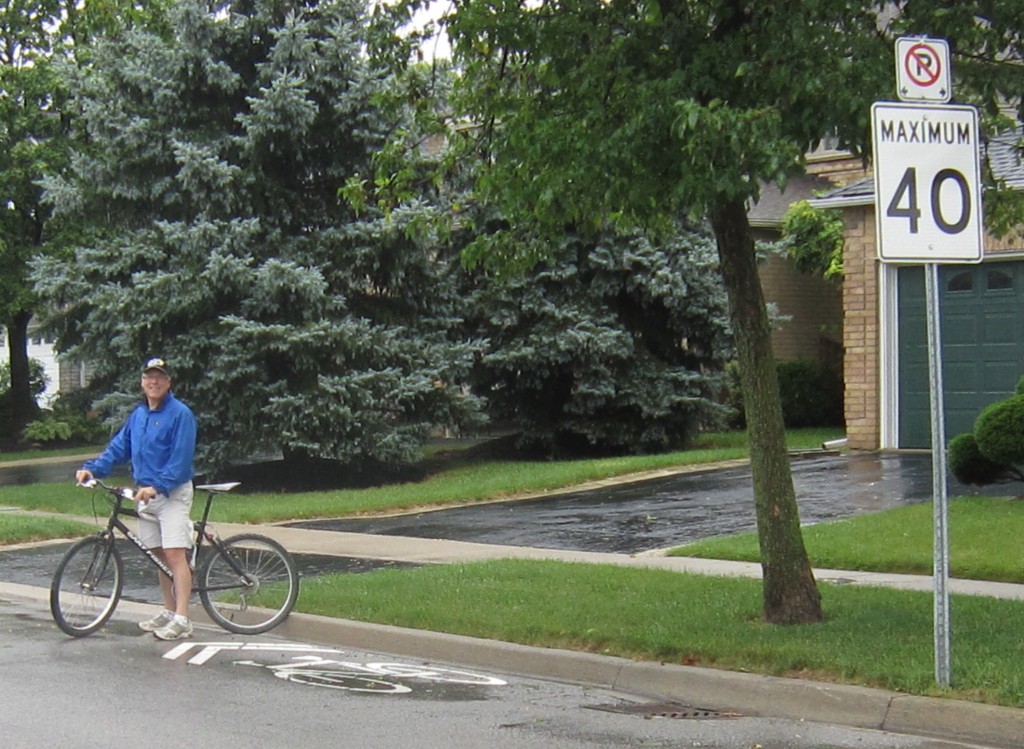BURLINGTON, ON October 12, 2012 Sustainable Development, is one of the city’s advisory committees; one of the Mayors favourites. They are hosting an event to show residents that there are several ways to enjoy cycling as a primary form of transportation in Burlington.
What does this have to do with sustainable development? And is cycling really a primary form of transportation in a city like Burlington and in the Canadian climate?
As part of the Take Action Burlington program, “Get in Gear” is bringing together medical, environmental and social experts to discuss ideal ways to make cycling safe, fun and rewarding in Burlington. The event – free – takes place at Central Library (2331 New St.) on Thursday, Oct. 18, from 7 to 9 p.m.
Special guests at Take Action Burlington: Get in Gear, include: Dr. Monir Taha, Assoc. Medical Officer of Health, Halton Region, Kevin Love, Burlington Sustainable Development Committee, Justin Jones, Clean Air Partnership, Abram Bergen, THAAT Delivery, and Jack Dennison, Burlington Ward 4 City Councillor

For Rob Narejko a good ride on one of his bikes is better than a night out. A passionate believer in greater use of bicycles, Narejko has served on the city’s cycling committee for some time. He recently led a night ride that had some 20+ people out on the roads at night.
“Burlington is a city of vibrant neighbourhoods criss-crossed by multi-use paths and bike lanes – and there will be more to come,” says avid cyclist and Ward 4 Councillor Jack Dennison. “It is a council priority to increase the number of people who cycle, walk and roll in Burlington.”
Dennison is a major supporter of cycle use in the city but during the process of setting the budget for 2012 he carved large chunks of money out of gas tax money we get for transit and shoved it into “shave and pave” – so that our roads will last a little longer. Now Jack will argue that he was saving money by investing in infrastructure and he might be right.
Scott Stewart, “general manager of development and infrastructure sees “a genuine need to make cycling in Burlington more accessible and more enjoyable. ” What does that mean? How realistic is it all?
Sustainable development has been defined in many ways, but the most frequently quoted definition is from Our Common Future, also known as the Brundtland Report: “Sustainable development is development that meets the needs of the present without compromising the ability of future generations to meet their own needs. It contains within it two key concepts:
the concept of needs, in particular the essential needs of the world’s poor, to which overriding priority should be given; and
the idea of limitations imposed by the state of technology and social organization on the environment’s ability to meet present and future needs.”
The sustainable development philosophy requires that we see the world as a system—a system that connects space; and a system that connects time. When you think of the world as a system over space, you grow to understand that air pollution from North America affects air quality in Asia, and that pesticides sprayed in Argentina could harm fish stocks off the coast of Australia.
And when you think of the world as a system over time, you start to realize that the decisions our grandparents made about how to farm the land continue to affect agricultural practice today; and the economic policies we endorse today will have an impact on urban poverty when our children are adults.
We also understand that quality of life is a system, too. It’s good to be physically healthy, but what if you are poor and don’t have access to education? It’s good to have a secure income, but what if the air in your part of the world is unclean? And it’s good to have freedom of religious expression, but what if you can’t feed your family?

Special lanes for bicycles and the speed at which vehicles travel along city roads are an ongoing concern for Rob Narejko who stands here beside recently painted sharrows on city streets.
The concept of sustainable development is rooted in this sort of systems thinking. It helps us understand ourselves and our world. The problems we face are complex and serious—and we can’t address them in the same way we created them. But we can address them.
Fine, I buy into most of that. No doubt in the minds of most people, that we are experiencing global warming and we’re pretty sure we know why this is happening. And, we know that we can do something about the way we treat the climate we have. But, is riding my bike down Guelph Line going to change the environment? It gives me a pretty decent chance of getting killed as I try to get over the QEW hump. I’m not safe until I get to Woodward Avenue, where I can make a right hand turn and pedal pleasantly along as I make my way to city hall, where I spend far too much of my time.
I’ll do what I can to save this planet. But please don’t ask me to get on my bike and roll along Guelph Line – it just ain’t safe.
At a recent Council committee meeting Rob Narejko, a biggy in Burlington cycling circles delegated on the speed limits on various roads in the city with Walker’s Line getting most of the attention. Walkers Line, north of Dundas, really isn’t a properly paved road; it’s a pitch and chip covered road that doesn’t have much in the way of a shoulder for cyclists but they like it nevertheless; it’s the safest of the three roads that carry traffic into the northern part of the city.
It is also the road the cyclists like to use because it has the kind of terrain they like and it is pretty safe as far as the speed of the passing traffic goes.
From a sustainability point of view – isn’t Walkers Line then a road we would want to upgrade so that there was space on the sides for cyclists and wouldn’t we want to keep the speed limit at the 50k? Isn’t that what we mean by sustainability?
There is an opportunity to develop a very healthy Eco-tourism business in the city if we provide roads that are safe and speed limits that take into account the fact that people use the roads as well. THAT is what sustainability is really about.
There was no mention of upgrading Walkers Line and there was no suggestion that this should be made a “wanna get” in our long range budget thinking. Unfortunate. It will be interesting to hear what the experts have to say.
Meanwhile Eva Amos, an Our Burlington reader, reflects what appears to be the prevailing view in this city: Burlington is “Quickly becoming not one of the very best places to live if you are a motorist in Burlington. The population is exploding, the roads are being narrowed, the aggressive driving is increasing largely due to the configuration of the roads. Prime examples are Lakeshore in the downtown core which was to have been a pilot project, deferred for review to 2011.
No review yet. Now the narrowing of Guelph Line, Walkers Line and Appleby Line south of New street and Plains Road. Stand on any one of these corners and with every light change you will see the aggressive drivers driving up the short curb lanes only to cut off the drivers in the single through lane. Add to this, the long line of idling cars trying to squeeze into the single lanes adding to the pollution. Councillors and Mr. Mayor. You are not going to get the majority of people in Burlington on bikes. Please give us back our roads so we can get around the city in a safe and timely fashion. We have wonderful bike paths throughout the city for our cyclists, I being one of them.




















Demographically, Burlington is a ‘Seniors City’. It has been for some time, and likely will be in the near future. Realistically, it is unlikely that there will be a massive demographic shift within the next two or three decades. Sooooo, as much as I do applaud those who cycle, I think we all have to keep in mind that taxpaying seniors have as much public wayfaring ‘Rights’ as cyclists. And, simply put, most seniors-over-60’s top priority is not to peddle 15 to 30 minutes this way and that picking up groceries or socialize with family & friends, (especially in winter or inclement weather). No, realistically, seniors, who make up the greater part of the City population, need affordable and reliable public transit as well as good and safe public footpaths.
We have all seen SUPER cyclists ‘hog’ the road in a type of ‘elitist’ superior pack fashion, ignoring the safety of road drivers. We have seen SUPER cyclists ignore seniors trying to cross boulevards, whizzing past with nary a blink. Recently, on the lakeside boardwalk, I literally saved a senior from getting knocked over when a group of ‘professional’ cyclists swooshed past. The senior, who had reduced vision, hearing and mobility, said she’d never walk there alone again as she was so afraid now of getting knocked down by the “bikers”. All in all, reckless and ‘superior’ cyclists are bullying others who are also just trying to live their lives ‘in public’. Aggressive cycling with total disregard for pedestrians and moving cars is a dangerous combination, an ‘accident-waiting-to-happen.’
A liveable city means EVERYONE gets a far shake. ‘Elitism’ – in any form – ultimately separates and eventually threatens good will and common civility amongst us all. Like I said, I’m all pro cycling, but not at the living expense of others on ‘public thoroughfares’, especially seniors, the most vulnerable of our community.
I agree with you Margaret that we have an aging demographic. Public transit and safe walking paths are extremely important for that group to prosper. Yet in many places, bicycles have improved mobility greatly for seniors, who either can’t, or don’t want to take the risk of driving on busy roads. As an example, my stepmom ‘s mother in England cycled every day in Southampton England until the age of 92.
Providing more bike lanes and facilities will make it less ‘elitist’ and democratize cycling, so that people of all ages have more options about how they get around. It will also ensure that riders don’t have to use the sidewalks in order to feel safe on busy roads. While I sympathize about aggressive cyclists being a danger, I think it hardly comes close to the terror that many seniors in our community feel when it comes to dealing with the automobiles which weigh 20 times as much and go many times faster than bicycles.
Your post seems to implicate all cyclists as behaving aggressively, which I can assure you is incorrect. And the best way to combat that stereotype is to get more people riding – including women, children and seniors. Cycling is perceived in Burlington as a high-risk activity, so currently those who are risk takers by nature (e.g. young males) make up a large proportion of cyclists. It’s critical for the rest of us to be out there and show them how its done- riding safely, respectfully and lawfully, and taking the perceived risk out of cycling.
To encourage more people to do this, we need safer places to ride than what we have now.
Cycling is for people of all ages and all economic backgrounds.
Education would go a long way to ensuring that pedestrians, cyclists and motor vehicles can safely co-exist. The MTO are revamping their drivers guide to include sections on cycling.
It would be beneficial if the HRPS, the Regional Health Dept and the Boards of Education (Public & Separate) would team up to educate young cyclists in the rules of the road, as they did in the 60’s when I was a kid.
If you want to stay healthy, especially important to your quality of life as you age, ride a bike. Cycling can assist people in obtaining and maintaining a healthy body weight, improving your heart and strengthening your muscles.
There are a few people over 75 in my neighbourhood who regularly cycle. They go the various stores and visit their friends.
What I’m not liking is the incessant ‘pitching’ to bike. Some just won’t, others just can’t. Seniors with vision, hearing and mobility problems are not safe on bikes.
Again, I applaud cycling as an healthy activity, but I am very conscious that it’s just not for everyone. And I’m ok with that.
I like cross country skiing, and think everyone should give it a go, also for their health. But it’s just not practical or ‘doable’ for many. And I’m ok with that too.
A bit more tolerance – and yes, ‘Rules of the Road’ education for ALL users – seems timely and appropriate.
Think of it this way. Every time someone gets on a bike, they are not taking a car for that trip. Since over 75% of our car trips are taken with a single occupant and over 50% are less than 5km (or 15 minutes by bike), that’s a huge amount of traffic that can easily be diverted if there is sufficient will for people to do it. And what creates that will? The first thing is support. The second thing is action – actually getting out there and giving it a try.
People in this city complain about gridlock all the time. But they don’t do anything about the gridlock they cause. I see parents who live less than 200 metres from school driving their kids instead of making the 2 minute walk. Cars lined up around the block, causing all kinds of hazards for kids who do travel on foot. It’s insane the degree to which Burlingtonians have become car dependent. It’s also very costly, both in terms of the personal cost of maintaining the typical two car household, as well as the public burden of maintaining all of that heavily used road infrastructure. Many would say this situation is financially unsustainable, in addition to environmentally unsustainable.
And someone actually has the gall to blame BIKE LANES for the aggressive actions of motorists on the recently reconfigured roads in the south end of town? Meanwhile, another $40 million or so is going to be spent on reconfiguring Guelph Line/Harvester and Walkers Line/QEW to make them even more of a barrier to cycling, thereby largely defeating the purpose of the token change at the south end.
Everything we’ve done in this city is all about accommodating cars. The bicycle infrastructure has been merely tokens in comparison. Halton is spending $615 million over the next 5 years to expand roads. The bike lanes on Walkers/Appleby cost what – $40,000? And for all that spending on roads we get no real relief from gridlock, as it just creates added incentive to travel by car and lessens the incentive to use other modes of travel.
Burlington will become a bike city when it wants to. And it will only display that desire when the planners and city councillors decide to get serious about tackling our gridlock issues and our infrastructure deficit in a sustainable way. Stop the ridiculous spending on propping up the private automobile, and make it just as easy for citizens to get from point A to point B, wherever that is, by bike. Build the separated bike lanes – along the length of all of our major arterial roads. Put the safety of the pedestrian and the cyclist first – longer crossing times, bike boxes for left turns, proper curb cuts at crossings, dedicated bike signals, etc. instead of prioritizing speed of motor vehicle travel.
Every one of these councillors, even the most ardent ‘supporters’ of cycling have bought into this idea that car dependency is a good thing. It’s killing us, and we can’t really even afford it.
Riding a bike:
1. helps the environment by reducing your carbon foot print
2. Is inexpensive as there is no fuel to buy, other than your meals which you will eat any way
3. Is healthy, two trips per day of fifteen minutes each is good for your heart, lungs and muscles keeping you out of the hospital and reducing our collective health costs
4. Is friendly, you meet the nicest people at stop lights
Here’s a challenge: make one trip per day on your bike and see the changes in yourself after one week
And for being unable to cycle year round, montreal is much colder and gets much more snow than Burlington, yet they have a thriving cycling culture.